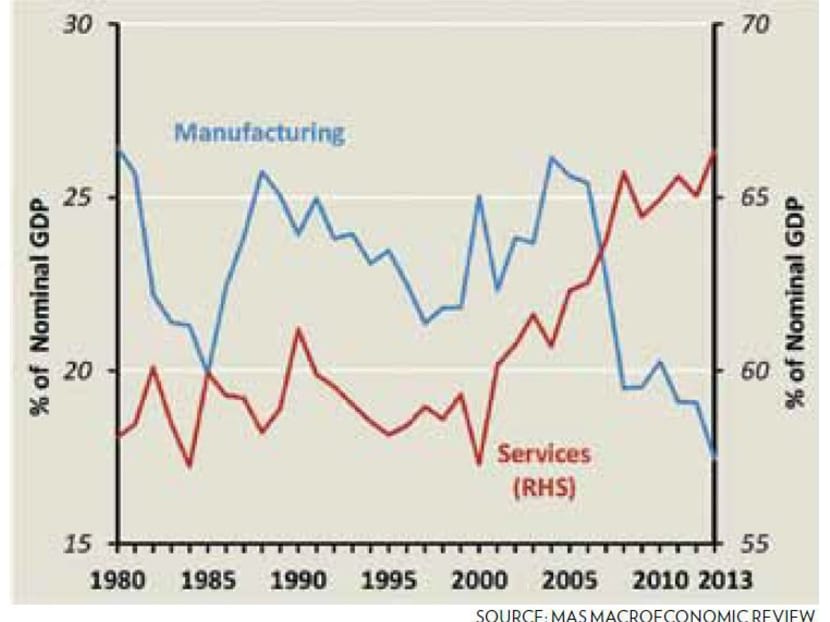Services sector becoming more crucial: MAS
SINGAPORE — The services sector — the main engine of economic growth in Singapore — will gain momentum as its contribution to gross domestic product (GDP) continues to increase while manufacturing’s share declines, the Monetary Authority of Singapore (MAS) said in its latest Macroeconomic Review report released yesterday.
SINGAPORE — The services sector — the main engine of economic growth in Singapore — will gain momentum as its contribution to gross domestic product (GDP) continues to increase while manufacturing’s share declines, the Monetary Authority of Singapore (MAS) said in its latest Macroeconomic Review report released yesterday.
And as the Republic transforms its economy, economists told TODAY the gap of GDP contribution between services and manufacturing, which hit an all-time high last year, is likely to keep widening.
The services sector accounted for around two-thirds of GDP at the end of last year, following a steady uptrend since 2000, the report showed, “buoyed by demand for financial services, business services and tourism”. Meanwhile, the contribution from the manufacturing sector to GDP fell to 18.6 per cent.
Singapore’s competitiveness in business services stems from its attractiveness as a location for regional headquarters, while the financial services sector is supported by globally competitive clusters, such as the fund management industry, the report said.
With the Asia-Pacific forecast to have the most high-net-worth individuals in the world by 2015, “rising affluence in the region continues to present opportunities for Singapore’s fund management cluster”, after the asset management and private banking segments together achieved stellar growth of 23.5 per cent last year, the central bank noted.
“Within manufacturing, multinational companies are also realigning their business operations to focus on delivering services complementary to the goods they produce,” the central bank added. “The shift … is likely to accelerate in the coming years due to the higher profit potential of such activities.”
Credit Suisse analyst Michael Wan said he expects the gap of GDP contribution between services and manufacturing to become bigger over the next decade. He said: “In 10 years’ time, Singapore is likely to become the New York or London of the east — you wouldn’t find a lot of manufacturing plants in these places, right? And it’s a positive development, part and parcel of Singapore’s productivity push as our economy goes through renewal and focuses more on higher-value-add activities.”
CIMB economist Song Seng Wun added: “Services-driven activities will continue to be the bulk of our growth driver, riding on Singapore’s status as one of Asia-Pacific’s hubs and leveraging on the region’s growing wealth and demand for various personalised services. I believe the trend of services gaining economic importance will continue.”
While its contribution to GDP pales in comparison to that of services, manufacturing will remain an important part of Singapore’s economy, UOB economist Francis Tan said.
“A competitive manufacturing sector has a lot of positive spillovers to support services, such as legal advice on patenting. But to thrive in our economy — one with cost and manpower constraints — manufacturers here must restructure for higher-value-add activities, from producing products to actually designing them, for instance.”
The shift towards more services-oriented activities will be especially important for the infocomm and technology industry, MAS said, as emerging trends such as big data and cloud computing dampen hardware and chip sales globally.
However, in the near term, Singapore’s electronics exporters can expect a more favourable outlook as economic conditions in the G3 — the United States, eurozone and Japan — continue to improve this year, MAS said. This is despite the softer prospects for ASEAN economies and China, where growth has slowed amid ongoing structural reforms.
“Singapore’s outlook is much more closely linked to the US and Europe than China,” Mr Wan said. “Our banking sector might be vulnerable to risks in trade finance as China’s economy slows, but its impact on Singapore’s overall economy should be limited and our GDP growth will be more noticeable in the second half this year.”
MAS predicted that the Singapore economy will grow 2 to 4 per cent this year, reiterating its forecast from earlier this month. However, it warned that “the ongoing restructuring towards productivity-led growth will generate further transitional frictions, notably in the form of higher labour costs through the tightening of foreign labour inflows.”
Due to the domestic cost pressures, full-year core inflation is expected to be 2 to 3 per cent, and could reach 2.5 per cent in the second half of this year, MAS said.







